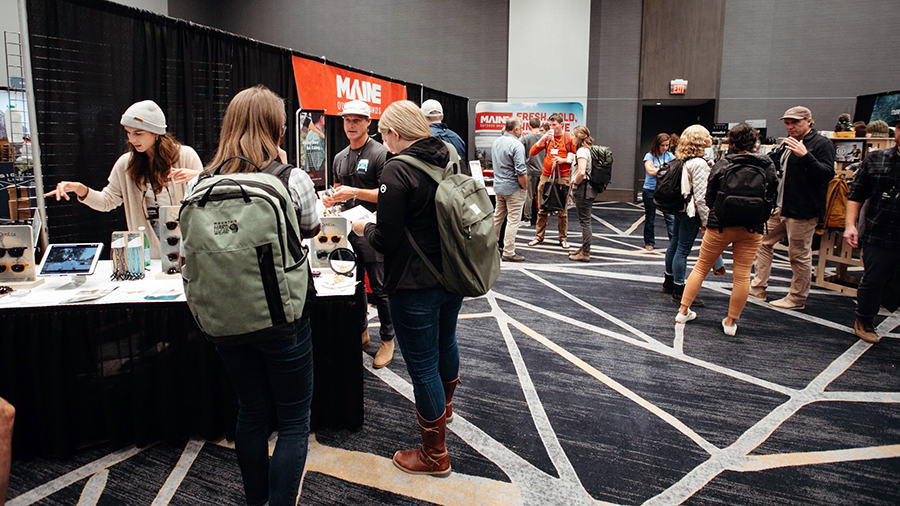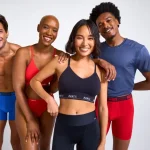Gabe Maier, president of Grassroots Outdoors Alliance, talked with SGB Executive about the work the membership organization is doing on behalf of independent outdoor retailers, its evolving Connect show and the prospects for a national show for the outdoor industry.
 Maier assumed the role of Grassroots’ president in June 2022 after having previously served for four years as vice president of the organization from 2017 to 2021 and two years as a business analyst from 2015 to 2017.
Maier assumed the role of Grassroots’ president in June 2022 after having previously served for four years as vice president of the organization from 2017 to 2021 and two years as a business analyst from 2015 to 2017.
Grassroots announced earlier this week that it had elected new board members and officers, and also announced that its twice-annual Connect show will relocate to Oklahoma City, OK, and Omaha, NE, starting in spring 2027.
The new board members include Todd Frank, owner of The Trail Head in Missoula, MT, who will also serve as board chair, and April Peterson, owner of River Rock Outfitter in Fredericksburg, VA. Returning members include Charlie Wise, co-owner of The Mountaineer in Keene Valley, NY; Ross Harris, co-owner of The Bear Mountain in Waco, TX; and Tina Miller, owner of Walkabout Outfitters, which operates six retail stores across Virginia.
SGB Executive: How did you find your way to Grassroots?
Gabe Maier: I played golf in high school and college and then professionally for two years outside of college. That was all I ever thought I was going to do. I was decent, but it’s a tough living. I was on the road a lot, and it’s tough to make friends, have a community and that kind of thing. So I moved back to Cody in late 2012. I grew up in the outdoors in Wyoming, but I wasn’t climbing or biking or skiing that much because I was always trying to focus on golf. So, when I moved back, I wanted to do all the things I missed out on, and I started with trying to get a job in an outdoor store. My first job in the outdoor industry was at Sierra Trading Post, where I worked on the floor. I made it about three months there, but selling credit cards as a primary form of engagement was not my favorite, and that was right at the time that they got bought out by TJX. So, I applied at Sunlight Sports, and I’ll never forget just going into that experience. I got married during that time to a woman I met at the store, and I worked there for about two years. I then had about a two-year stint doing commercial real estate appraisal and during my time away, Wes Allen, the owner of Sunlight Sports, had become president of Grassroots. I was looking at making another job change, and they had a business analyst role open up. So, I applied, and the rest is history.
SGB: How did Grassroots get started? Has its mission changed?
Maier: It was started by four retailers in 1994 as a co-op and was originally formed as a company named ROI, or Retailers of the Outdoor Industry. Prior to that, those retailers, along with many others, had been getting together at Outdoor Retailer in a group called Retailers of the Round Table. They’d sit around a round table and stay up until 2 a.m. talking about things they were excited about, challenges they faced, how to do business, just sharing information. So, when ROI got started, it was essentially just a formalization of that, and it was around three primary focal points. The first was making sure that any specialty retailer’s needs were cohesive and expressed in the industry. Secondarily, to have that community of retailers and a place to share and learn. And then third was wrapped around bringing some professionalism to the buying group side, so paying bills on time or acting professionally as retailers, and then also trying to form programs with brands to help margins.
In 2006, we went from ROI to Grassroots Outdoor Alliance. So those three founding principles are very much what we act on today: community for retailers, sharing best practices and trying to advocate for specialty needs in the industry. It’s actually something I bring up frequently in our membership meetings because even though we have 105 retailers now, we start off our pre-show Education Day with all of them sitting around round tables talking to each other. It’s still very much how we do business.
SGB: What has been your priority since taking over?
Maier: It’s been really important to me to just grab hold of that foundation story firmly and consistently, and reinforce that we’re not a top-down organization. This group was formed by retailers trying to find solutions to things they felt were important for them, and our staff is here to support that. So, today, while we do make decisions, it’s really trying to build consensus among retailers and try to put effort and energy into the things that are hopefully going to help them be the most successful, and the same on the brand side. While the show is how we’re known most visibly, the membership side of the business is the most important thing.
SGB: When did Grassroots Connect start, and how has that evolved?
Maier:Our first June show was in 1998 in Lake Tahoe, and then the fall show came a couple of years after that, so we’ve been doing two shows a year since around 2000. The general show format and its function have remained pretty much the same since 2015, when the first Connect show took place. Prior to 2015, they were called Summit, and they were just for members. 2015 was the first time that we invited in guest brands and guest retailers outside of membership. But we see small increases in participation at the shows every year and that’s pretty intentional. We’re much more focused on quality over quantity as we look at the events, ensuring that the right brands and the right retailers are there and that they can get their business done efficiently.
Probably the biggest change recently has been the addition in fall ’22 of Discovery Marketplace, which is built around introducing either new brands to retailers or brands with a new wholesale strategy to hopefully start to begin meaningful relationships. It happens on Sunday, our Education Day, and we’ve grown from around 40 brands to up to maybe 100.
SGB: The regional shows became more critical buying shows during the pandemic. Do you find yourself competing more against them?
Maier: We look at regional shows as very complimentary to everything that we do. While we serve a similar purpose, buying and showing the line takes a lot of time and there’s a lot of people involved. All those shows are needed to get the work done. I would say that we’ve all had to just stay focused on what we’re doing and provide that value, which has really been focused on efficient buying.
SGB: Does the outdoor industry need a national show?
Maier: From my personal perspective, if you define a national show as supporting idea generation and education as well as the media and nonprofits, there’s a ton of value to the industry gathering as a whole and getting together, like a prior version of what Outdoor Retailer used to bring to the industry. You could walk in and kind of breathe in the culture of the industry in five minutes and really get a sense for where things were at. We’re not doing that necessarily today. We provide a little piece of it and regionals provide a little piece of it. I think Switchback and Outdoor Retailer are providing little pieces of it. But it’s not that thing that used to be there. I think the more that those shows define their value and their purpose, the easier it is for a retailer to decide whether it’s something that they want to plan in their calendar.
SGB: What are your thoughts on the timing of a national show?
Maier: Not to say buying doesn’t happen at a national show, but if we agree that maybe it’s not their primary function, putting a national show in the middle of a busy buying season, I think limits the opportunity for the greatest amount of attendance. We’ve also co-located our show with Outdoor Retailer in fall 2018 and one of the key learnings from that was that after four days of buying and vendors setting up booths, were there even more days; most folks were just purely out of gas. Even though it was really valuable to continue on and have another show experience, co-location kind of showed our limits as people on whether we can sustain it for that long.
SGB: We’ve heard grumblings about both Switchback Spring and the Outdoor Retailer shows held less than two weeks after the June Grassroots Connect show took place in Reno. We did hear some attendees calling for an August national show. Is that more ideal?
Maier: What I’ve found when I walked the shows with buyers pre-pandemic, when Outdoor Retailer was held in the August timeframe, is that buyers had already submitted a lot of their key orders, so they would go into that show with the benefit of knowing they needed to find that one thing their core brands didn’t have. Knowing what the rest of their buy looks like also provides a chance to follow up on the orders that they had just written, and then they can also talk about marketing plans and those kinds of things, as well as the upcoming season. Whereas June tends to be very tactical, they could be a little bit more strategic in August.
SGB: How is the outdoor specialty channel performing these days?
Maier: Our members report their top-line sales, margin, and other things every month. So, if we look back to fall 2024, August was our first sales comp month up since January 2023, and then we saw comp growth in November and December. So, comps were starting to flatten out, rather than being down every single month, and that’s continued into the first half of 2025, where we’ve seen probably half of the months be comp up and half of them down. Obviously, some retailers are doing better or worse than others. But I can say, generally, through the first half of 2025, sales are pretty flat. For the second quarter, sales were up within our group by 1.35 percent over 2024. Margins have also been pretty flat. So, if you put aside all the chaos with tariffs, public lands and general global instability, it feels like the outdoor channel’s in a decent place. It’s just a matter of how much those macro trends are going to affect everything.
SGB: Is the outdoor space still seeing benefits from the pandemic experience?
Maier: I really do feel we had the opportunity to learn a lot during the pandemic. If there were ever going to be the off ramp into more pure-play e-com for outdoor, that was going to be it because it was essentially forced. And what we saw was the opposite. Coming out of the pandemic in terms of specialty retail, we’re just seeing a good, genuine focus on brands developing a more complete ecosystem in terms of balancing their DTC and their wholesale mix and I think specialty retailers and probably wholesale in general are having a nice time right now. While everything’s not perfect, physical retail has kind of proven to be stable and important moving forward.
SGB: Is Grassroots working on any other initiatives you’d like to call out?
Maier: In a data sense, we brought on a data engineer about 18 months ago. We’ve been working on a data aggregation system internally, which will be a member benefit. We just started recording all of our education sessions and are working on a better education resource library for our members, retailers and brands. Previously, we’d have a great session, and then it’s kind of gone, so we want to make sure we’re capturing those moving forward. From an advocacy standpoint, we launched the Grassroots Stories B2B media platform around our shows last fall to celebrate what’s going on with retailers and brands and things that are working well, but also help foster healthy dialogue in areas that need it. But we remain focused on the membership benefit side, which does lean into making sure that the show is efficient.
Images courtesy Grassroots Outdoor Alliance/Grassroots Connect
















